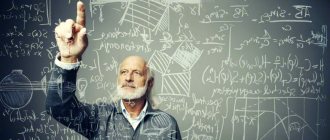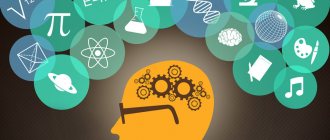The main role of associations in memorization is that we link new knowledge to information we already know. To build a good association, you need to know some useful criteria for finding connections between things, as well as develop your associative thinking and creative imagination. It is equally important to learn how to build associative series and connections to stimulate figurative memory.
This lesson will show you how to use the association method to remember information.
What is an association
Association
- this is a naturally occurring connection between individual objects, phenomena, facts, reflected in our consciousness and enshrined in memory. It is important that associations do not exist in external reality, but are generated by the human brain.
The idea of the existence of associations arose in ancient times; Plato, Aristotle and other ancient thinkers discussed this. However, in the Middle Ages, the development of science stopped in many ways, including in this area. The term “association” itself was introduced only by John Locke, an English scientist of the seventeenth century.
How do such relationships arise? The human brain is a complex information processing machine. The data entering it is subjected to various processing, including analysis, synthesis, and comparison with each other. At this time, short-term nerve connections are formed in the brain, due to which the similarity of any objects and phenomena is revealed.
For example, a person sees an object. The visual image enters the brain, which thoroughly studies it, and it generates similar images from those that the person has seen before. This is how an association arises.
Thus, association is the result of the coexistence in our minds of a large number of images, between which there may be some similarity.
Something similar can be observed on the Internet – in modern search engines. As soon as we start entering the first letters of the query, the search engine immediately offers possible options that have the typed combination of letters. Thus, “in the mind” of the World Wide Web (or a separate computer), previously downloaded “images” are generated that have some resemblance to the new information.
Associations are a product of developed abstract thinking. Therefore, they are characteristic only of human consciousness and the consciousness of other higher primates. For example, the Yerkish language, which has only a written form and is intended for communication with monkeys, is based on the ability to build associations. The more developed a person’s intellect, the greater the number of different associations to one subject he can generate. It is known that people with intellectual disabilities have certain difficulties in understanding the connections between objects.
I.M. Sechenov, an outstanding Russian scientist, devoted himself to the study of associations. Studying the reflexes of the brain, he came to the conclusion that associations are, as it were, the contact of a previous reflex with a subsequent one.
Connections between phenomena and objects arise spontaneously and continuously, since sensations and reflexes of the brain also arise continuously. Irritants that cause associations can be both external factors (seen, heard, etc.) and internal (for example, abdominal pain makes you remember about eating too fatty a piece of meat at night). Even thoughts can serve as irritants. It often happens that some random thought gives rise to a whole cascade of other thoughts and images. The English researcher T. Buzan aptly compared associations with fireworks: first one thought arises, which “explodes”, giving rise to several new ones, which also “explode” and give rise to many more thoughts - and so on many times.
Synectics is a form of searching for new ideas using analogies.
Published: 03/04/2018
Synectics is a form of searching for new ideas through the construction of analogies. Author - W. Gordon (USA, 1952). Synectics is an advanced brainstorming method based on the principle of “making the known strange and the strange known.” The synectics method, like other methods of associative search for ideas, is based on the ability of the human brain to establish connections between words, concepts, feelings, thoughts, […]
no comments yet
Associations in psychology: main types
Connections between phenomena and objects may affect one or another aspect of them.
In this regard, associations of various types are distinguished:
- Associations by similarity
. Objects are similar in appearance to each other: an apple is a ball, a light bulb is a pear, a spoon is a shovel, etc. - Associations by contrast
. In this case, objects have opposite characteristics: black - white, wet - dry, heavy - light, etc. They are considered the most complex type of associations, and they have not yet been sufficiently studied. - Associations by contiguity in time or space
. In this case, both objects are located close to each other in space or time: summer - vacation, winter - snow, table - chair, etc. - Causal associations
. Objects here are the cause and effect of each other: a light bulb is light, rain is a puddle, poison is death, etc. - Associations by meaning
. These are relationships between objects that reflect a person’s personal experience and may be incomprehensible to the uninitiated. For example: airplane - love. For an ordinary person, there is no connection between these concepts; however, for someone who once flew on a plane and met a girl with whom he fell in love, this pair of concepts has an absolutely concrete and unambiguous connection.
The emergence of associations is an important condition for full-fledged thinking.
Their formation is influenced by several factors
:
- The speed of nervous processes, which determines the speed of brain reflexes
. The higher this speed, the faster associations arise and the more diverse they are. - Memory and the information stored in it
. A person with a good memory will generate richer and deeper associations, therefore, the results of thinking in this case will be more original. - Imagination
. When associative connections are born, the emerging images undergo transformation, their elements are combined in different combinations. This is how the imagination works, and its work is extremely important for the functioning of thinking as a whole. - Subconscious
. Associative processes spread throughout the brain, affecting the subconscious area. This part of thinking is usually beyond our observation and control, and association is one of the few ways to get there.
Usually associations are of an individual nature, because they are connected with personal experience. However, among them there are some that are common to a large number of people, and even some that cover the majority of people. Thus, most people associate snow with winter, and heat with summer.
The test question method will help launch the creative process
Published: 03/17/2018
The test question method is a creative technique that allows you to look at a problem from different angles using a list of questions and find a non-standard solution. It will be useful for designers, copywriters, engineers, screenwriters, scientists, and anyone who needs to find a non-trivial solution. It should be said that this technique does not have an author as such. Equally, many techniques use lists of questions. The sequence of actions when using the method […]
no comments yet
Use of association methods in psychodiagnostics
Associative connections can be used in psychodiagnostics to study human mental states. Scientists became interested in this problem at the dawn of psychology as a science. Thus, Sigmund Freud, one of the founders of the science of the unconscious, believed that the subconscious contains repressed desires and instincts of a person that contradict the demands of society. These repressed desires are driven into the “very corner of the brain,” but they do not disappear completely and continue to influence a person’s thinking and behavior. He develops certain phobias, he does strange things, he even develops mental and physical illnesses. Repressed desires, as Freud believed, can be identified using associative diagnostics.
Associative connections arise spontaneously and carry information about existing suppressed instincts and desires. Freud used the method of free association, which is still used today. The identified associative connections allow the specialist to make an accurate diagnosis.
This method is very simple, although it looks strange. The patient should sit comfortably, relax and talk about anything. At the same time, he speaks exclusively about what first comes to his mind.
Currently, some psychologists do not use free associative connections, but rather more organized and controlled ones by a specialist.
To identify associative connections, specialists analyze many aspects of the patient’s life. This is, for example, creativity. When a subject draws a scene, he will certainly use the associative connections that arise.
Of particular interest for study is associative thinking. It is often opposed to logical thinking, and there are certain reasons for this. This kind of thinking allows you to quickly connect information from different areas to solving a problem. This type of thinking acts as if bypassing logic. The solution to the problem in this case can be not only faster, but also deeper, and the approach to this solution can be non-standard.
Associative thinking can be developed, and in the modern world it is advisable to do this. Psychologists have developed many techniques for developing associative thinking skills.
This attention to this type of thinking is explained, in particular, by the fact that logical methods are relatively simple, and at the present stage of human development it is often necessary to solve more complex problems; In addition, logical thinking is increasingly becoming the prerogative of computers, and therefore people are moving on to solving issues where a machine is fundamentally unable to cope. However, researchers nowadays are trying to teach artificial intelligence associative thinking, and there have already been some successes in this direction.
Associative thinking is the area in which human individuality is most clearly manifested. Since most associative connections are of deeply “personal” origin. In our time, one might say, the very understanding of the essence of man is changing. If previously it was customary to hide and suppress personal experience in order to better comply with “social norms,” today it is the personal approach to various things that becomes more profitable. In the future, it is quite possible that a person in his activities will be guided mainly by associative thinking.
Features of associative thinking
It has been established that the number of direct associative connections of any concept (word) is on average about ten. One associative step allows you to choose from 10 words, the second - from 102, the third - from 103, the fourth - from 105. Thus, each step increases by an order of magnitude the number of connections of a given concept with other concepts according to certain characteristics, which significantly expands the possibilities selection of solution ideas.
A feature of associative thinking is the ability to identify common features of things - to generalize without conducting logical analysis. Associations can be seen as a source of additional information that can be used in the creative process.
Associations are capable of “pulling out” from the recesses of our consciousness the most diverse, often quite unexpected, memories, images, thoughts, which significantly expand the area of creative search.
Methods of associative search for ideas are good, for example, when creating the plot of an advertising video. Unexpected elements attract attention and make people focus on the advertisement. You can search for associations using visual images. In Google, Flickr, Pinterest, search for the word of interest. The result is an expansion of the range of creative solutions and inspiration for their development.
Reorganization
The association may be reorganized into various forms of non-profit organizations.
When reorganizing this entity, all documents that are significant are transferred to the state, namely to the archives
If there are any, documents with information about personnel are also transferred to the state. When transferring documents, in which they will be stored must be met
The liquidation of an association occurs either by a court decision or by a decision of its members. In case of liquidation, a special commission is appointed, which sets deadlines and determines the procedure for liquidation.
Property
The association's property is formed from the proceeds of the founders, voluntary contributions and income received from securities, deposits and shares in which funds were previously invested.
Association in Chemistry
Association is the combination of molecules or ions into groups that make up more complex compounds , but do not change the chemical nature of the substance.
There is an association of ions and molecules . Ions group together under the influence of electrostatic forces. The minimum number of ions in an association is two.
The association of molecules is created due to molecular forces of attraction. Affects the properties of solutions and the formation of complex compounds.
Association is a concept used in different fields of knowledge and in its own way irreplaceable. The correct use of such terms is the basis for a correct understanding of the essence of the subject area.











